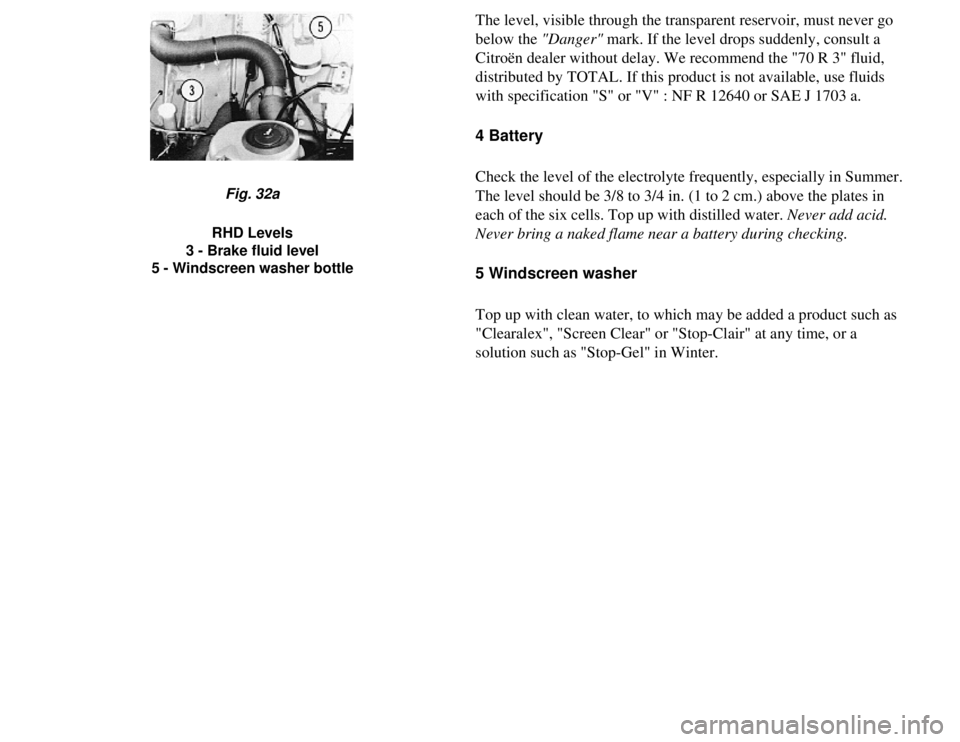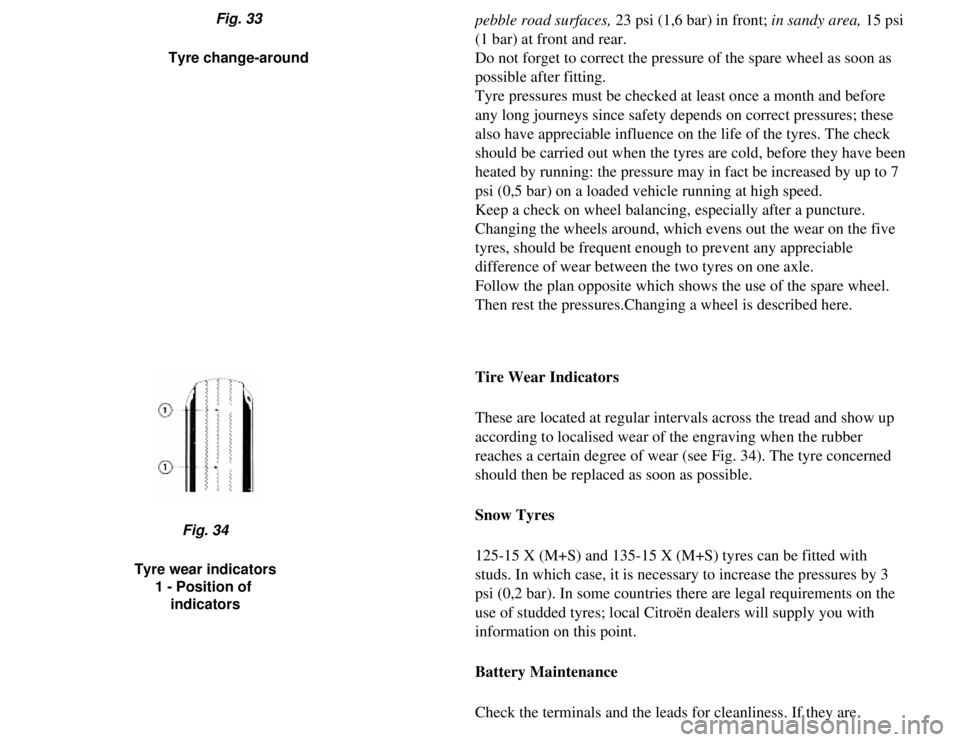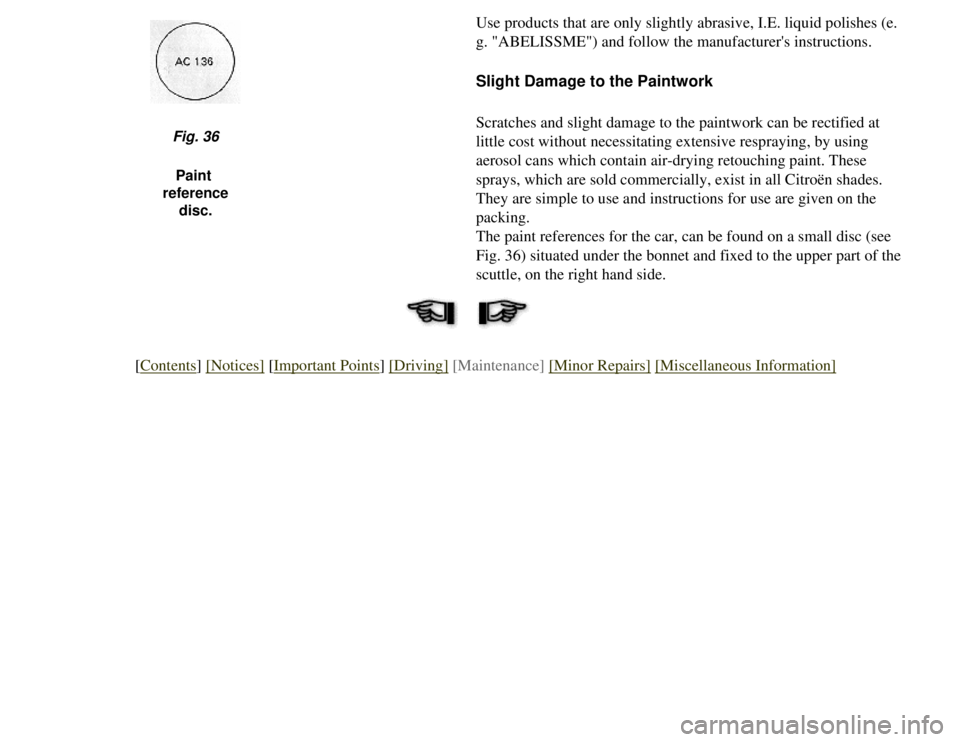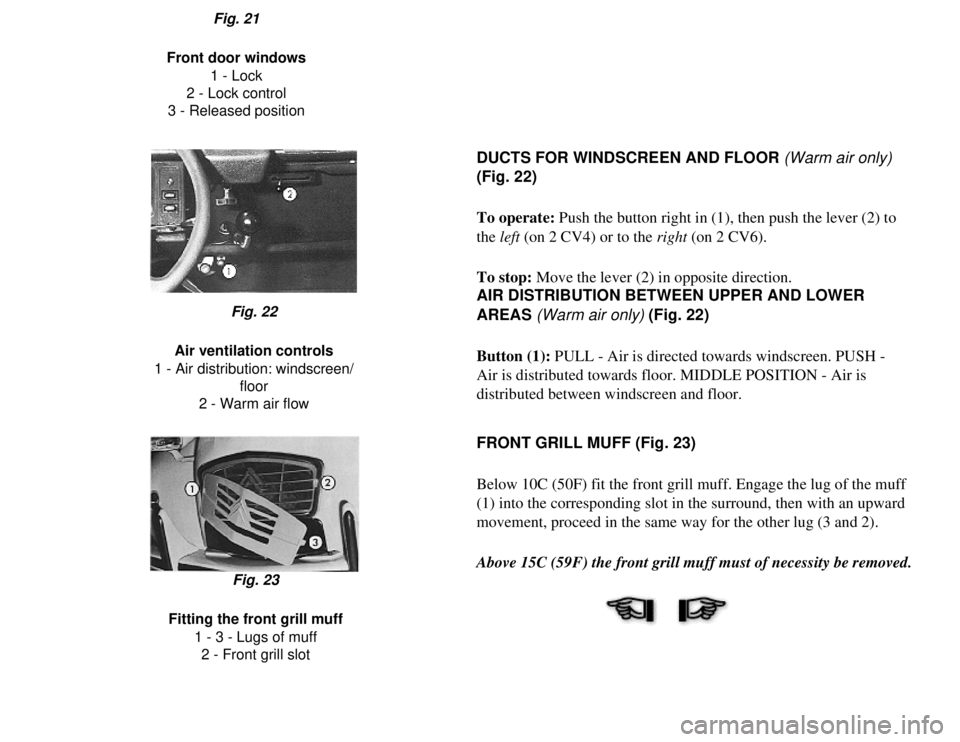1975 CITROEN 2CV ESP
[x] Cancel search: ESPPage 10 of 86

With the exception of the warning lamps for engine oil pressure (2) an\
d hazard warning device (6),
the illumination of the following dashboard instruments is controlled by\
the exterior lighting switch.
These instruments do not function when the ignition is off, with the exc\
eption of the hazard warning
device (6).
1 - Speedometer: The red marks indicate maximum speed permitted in each gear.
2 - Engine oil pressure warning lamp (2 CV6 only): This lights up when the ignition is switched on
and goes out as soon as the engine is running. If it lights up when driv\
ing, stop the engine
immediately and top up the level of oil if necessary. If the lamp remain\
s alight despite the oil level
being correct, stop again and contact a Citroën dealer.
3 - Fuel gauge: Tank capacity: 4 1/2 Imp. Gal. (20 litres)
4 - Total mileage indicator
5 - Charge indicator: At normal engine running speed, the needle should remain in the white se\
ctor.
If the needle should remain in either of the red sectors, consult a Citr\
oën dealer. It is possible that,
when driving with the headlamps on, the needle may stay in the white cro\
ss-hatched zone - indication
that the battery is insufficiently charged. In normal circumstances, whe\
n driving, the generator should
charge the battery and within two hours the needle should return to the \
white zone. If this does not
occur, consult a Citroën dealer.
6 - Hazard warning lamp: Flashes throughout the operation. If it does not function, check the
direction indicators.
[Contents] [Notices] [Important Points] [Driving] [Maintenance] [Minor Repairs] [Miscellaneous Information]
Page 21 of 86

The level, visible through the transparent reservoir, must never go
below the "Danger" mark. If the level drops suddenly, consult a
Citroën dealer without delay. We recommend the "70 R 3" fluid,
distributed by TOTAL. If this product is not available, use fluids
with specification "S" or "V" : NF R 12640 or SAE J 1703 a.
4 Battery
Check the level of the electrolyte frequently, especially in Summer.
The level should be 3/8 to 3/4 in. (1 to 2 cm.) above the plates in
each of the six cells. Top up with distilled water. Never add acid.
Never bring a naked flame near a battery during checking.
5 Windscreen washer
Top up with clean water, to which may be added a product such as
"Clearalex", "Screen Clear" or "Stop-Clair" at any time, or a
solution such as "Stop-Gel" in Winter.
Fig. 32a
RHD Levels
3 - Brake fluid level
5 - Windscreen washer bottle
Page 24 of 86

pebble road surfaces, 23 psi (1,6 bar) in front; in sandy area, 15 psi
(1 bar) at front and rear.
Do not forget to correct the pressure of the spare wheel as soon as
possible after fitting.
Tyre pressures must be checked at least once a month and before
any long journeys since safety depends on correct pressures; these
also have appreciable influence on the life of the tyres. The check
should be carried out when the tyres are cold, before they have been
heated by running: the pressure may in fact be increased by up to 7
psi (0,5 bar) on a loaded vehicle running at high speed.
Keep a check on wheel balancing, especially after a puncture.
Changing the wheels around, which evens out the wear on the five
tyres, should be frequent enough to prevent any appreciable
difference of wear between the two tyres on one axle.
Follow the plan opposite which shows the use of the spare wheel.
Then rest the pressures.Changing a wheel is described here.Fig. 33
Tyre change-around
Tire Wear Indicators
These are located at regular intervals across the tread and show up
according to localised wear of the engraving when the rubber
reaches a certain degree of wear (see Fig. 34). The tyre concerned
should then be replaced as soon as possible.
Snow Tyres
125-15 X (M+S) and 135-15 X (M+S) tyres can be fitted with
studs. In which case, it is necessary to increase the pressures by 3
psi (0,2 bar). In some countries there are legal requirements on the
use of studded tyres; local Citroën dealers will supply you with
information on this point.
Battery Maintenance
Check the terminals and the leads for cleanliness. If they are
Fig. 34
Tyre wear indicators 1 - Position of indicators
Page 26 of 86

MAINTENANCE
Maintenance
Bodywork
The bodywork should be looked after regularly, especially in
Winter. This maintenance should not only concentrate on the
paintwork and the metal embellishers but should take in the
underside of the car as well: advice in this connection can be
obtained from any Citroën dealer.
Never wipe the car when dry since this will scratch the finish.
Petrol, trichlorethylene and alcohol harm paint and transparent
plastic such as the sidelamp covers. Do not use strong detergent
solutions either.
Cleaning the Bodywork
Frequent washing is necessary to keep the paintwork in good
condition but it is nevertheless essential that certain precautions be
observed; here are some reminders:
Never wash the car in full sunlight nor during frost. If the car has
been exposed to the sun or if the bonnet is still warm after a
journey, wait until the surfaces have cooled down.
The body should first be rinsed with copious amounts of water
applied either with a soft sponge, exerting no pressure and rinsing
the sponge often, or with a low pressure jet. If a car shampoo is
used, risne afterwards with plenty of water.
Wipe the car dry with a clean chamois leather which is rinsed and
wrung out frequently, ensure that no spots of water are left on the
paintwork.
Page 28 of 86

Use products that are only slightly abrasive, I.E. liquid polishes (e.
g. "ABELISSME") and follow the manufacturer's instructions.
Slight Damage to the Paintwork
Scratches and slight damage to the paintwork can be rectified at
little cost without necessitating extensive respraying, by using
aerosol cans which contain air-drying retouching paint. These
sprays, which are sold commercially, exist in all Citroën shades.
They are simple to use and instructions for use are given on the
packing.
The paint references for the car, can be found on a small disc (see
Fig. 36) situated under the bonnet and fixed to the upper part of the
scuttle, on the right hand side.
Fig. 36Paint
reference disc.
[Contents] [Notices] [Important Points] [Driving] [Maintenance] [Minor Repairs] [Miscellaneous Information]
Page 49 of 86

MISCELLANEOUS INFORMATION
Running-in, servicing, guarantee, running costs, towing a trailer, vehicle identification, replacement parts
RUNNING-IN
During the first 1,200 miles (2,000 kilometres), avoid over-revving,
and do not let the needle reach the coloured marks of the
corresponding speed ranges, before changing gear. Also avoid
during this period:
-harsh acceleration,
-fierce braking (the brake linings must be run in),
-long journeys at constant speed,
-labouring the engine at too low a speed.
SERVICING AND GUARANTEE
At the time of delivery, you will be given a "Maintenance Guide",
with a "Guarantee Card" and a 600 miles (1,000 km) "Servicing
Certificate".
On completion of the first 600 miles (1,000 km), any Citroën dealer\
,
whether he supplied the vehicle or not, will service the car, free-of-
charge, on presentation of this "Maintenance Guide".
It is particularly important that the oil filter cartridge, which has to\
comply to the standard regulations, should be of the type
recommended by Citroën.
Only the cost of the materials used will be charged for.
The dealer will keep the Servicing Certificate and sign the
Guarantee Card.
Page 50 of 86

This card must be signed for you to benefit from the guarantee.
INFLUENCE OF DRIVING TECHNIQUES ON RUNNING
COSTS
The manner in which a car is driven affects its running costs,
particularly as far as fuel, oil, and tyre expenses are concerned.
Running costs increase notably with:
-speed,
-frequent and prolonged use of low gears,
-accelerating and braking too often or too fiercely,
unnecessary use of the accelerator pedal,
-leaving the choke out,
-taking bends at high speeds,
-tyre inflated to incorrect pressures.
Oil consumption, which varies a great deal with the use of the car,
is also influenced when running in the engine, and you are advised
to pay particular attention to this point as well as to the oil change
section in the Maintenance Guide.
TOWING A TRAILER
If you intend to tow a caravan or trailer, consult your Citroën deale\
r
first, who will give you all the necessary advice, especially in so far \
as the legal requirements are concerned.
The maximum towing weights are, in France:
- Trailer without brake: 270 kg (595 lbs)
- Trailer with overrun brake: 400 kg (881 lbs)
IDENTIFICATION
Positions
Manufacturer's plate:Under the bonnet on the scuttle panel, RH
side.
Page 78 of 86

Fig. 21
Front door windows 1 - Lock
2 - Lock control
3 - Released position
DUCTS FOR WINDSCREEN AND FLOOR (Warm air only)
(Fig. 22)
To operate: Push the button right in (1), then push the lever (2) to
the left (on 2 CV4) or to the right (on 2 CV6).
To stop: Move the lever (2) in opposite direction.
AIR DISTRIBUTION BETWEEN UPPER AND LOWER
AREAS (Warm air only) (Fig. 22)
Button (1): PULL - Air is directed towards windscreen. PUSH -
Air is distributed towards floor. MIDDLE POSITION - Air is
distributed between windscreen and floor.
Fig. 22
Air ventilation controls
1 - Air distribution: windscreen/ floor
2 - Warm air flow
FRONT GRILL MUFF (Fig. 23)
Below 10C (50F) fit the front grill muff. Engage the lug of the muff
(1) into the corresponding slot in the surround, then with an upward
movement, proceed in the same way for the other lug (3 and 2).
Above 15C (59F) the front grill muff must of necessity be removed.
Fig. 23
Fitting the front grill muff 1 - 3 - Lugs of muff2 - Front grill slot